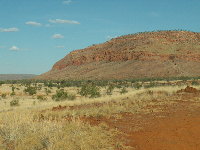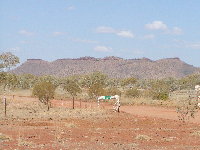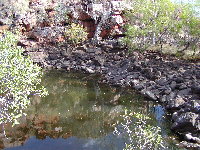|
|
The Kimberley – A Bird Keeper's Dream Come True! By Marcus Pollard "It was a day like any other." That is if yours usually starts at around 4 am for a 4:30am kick-off! You throw on whatever clothes are closest, after selecting for the darkest ‘commando Ken’ colours of course, and fall out of the tent opening. A quick briefing at "Finch Headquarters" and it’s out to your allocated waterhole or, in the majority of cases, a small shallow puddle. You settle in by trying to find a spot free from annoying
sharp rocks and even more pesky sharp-nosed insects for they’ll only get
sharper and more peskier during your 2 hours at ‘the finch front’!! Having
found a semi-secluded vantage spot you do your best impression of a
motionless stick! Still no finches! By now the sun has burst over the horizon and as a poor cold-acclimated Taswegian you begin to sweat rather profusely! This, naturally, makes you irresistible to a hoard of even more annoying flies and a bevy of ‘interesting insect taxa’! Trying to dispatch a fly while wishing to remain in stick mode is extremely difficult! Half an hour later success as you trap said fly. Thirty seconds later several of his cousins locate you. Your two hours is up and all you have to show for it are two Black-rumped Double Bars at your water hole. Trudging wearily and not a little dispiritedly back to your vehicle you stumble onto a flock of around 30 Double Bars which flit out of the low grass in all directions. "Where were all you guys when I need you a few minutes ago!!" you think to yourself. Back at finch headquarters for debriefing and you wince as
you hear the others tabling their reports with "dozens of Gouldian’s
sighted plus hundreds of Longtails, dozens of Painteds and untold numbers of
Double Bars spotted".
I guess many of you are probably wondering whether the sun up there was just
too much for him this time!! A short phone call from Mike & Elisabeth Fidler one
evening ended with the statement that: "We think you should come up with us
to Mornington, to see the Gouldian’s in the wild." A seemingly very short time later I stepped from the Qantas jet onto Broome Airport and immediately felt like an ice-cream in an oven! From there it was into a 4WD (did I mention it was air conditioned!!) and out to the Mornington Wildlife Sanctuary for a look at one of the few remaining wild homes of the endangered Gouldian finch. Following a brief introduction to the Camp it was time to
try and work out what some of the myriad of birds flying around were called
and to just marvel at the rugged Kimberley landscape. The appearance of what
could only have been an ancient seafloor dominating the landscape in every
direction and the magnificent almost polished texture of the quartzite slabs
surrounding the Gorges………ok, ok, I’ll save all that for the Geologists
Monthly! Let’s just say it was stupendous, stunning and breathtaking from
dawn to dusk, day after day! The evening meal at the Camp was taken with the two AWC
scientists, Steve Murphy and Sarah Legge, who call Mornington home and who
are trying to piece together the puzzle that is the decline of the Gouldian
finch in the wild. Perhaps at this point it is advantageous to give you some idea of the problems that have beset the region in the past. As many readers would be aware vast expanses of the Kimberley area have long been used for cattle ranching. As an economic enterprise this was a lucrative albeit hard won success story with much of the countries cattle wealth generated from this region. However, as is true of many wilderness areas in Australia, little regard was paid to the ecology of this fragile environment and how the interaction of its creatures were screaming that something major was rapidly unravelling.
Check how many small macropods have disappeared in the wake of cattle ranching where trampling of water sources destroys the habitat of these marsupials. It only takes a very cursory glance at the environment of this vegetation type to work out that the availability of water sources is of paramount importance to the survival of all the creatures that eke out a living in the Kimberley. You can take a walk through the scattered trees and feel the grass crinkle and break under your feet as you step through it and wonder how anything could possibly survive the dry out here. Suddenly you happen upon a waterhole ringed with Pandanus palms and lush with green vegetation of all types and it is like you have stepped into another world! Then you imagine how that waterhole would suffer from the depredations of a herd of cattle desperate for a drink and a feed of anything but dry grass. Unfortunately it must be a scene that is repeated at many such water sources throughout the dry season with the native fauna and flora the inevitable losers. Just sitting and listening to the locals describing the effect of just such cattle ‘visitations’ upon a Pandanus grove certainly was an eye opener as the Palms themselves certainly did not look like they’d readily succumb to anything short of attack by an armoured brigade! Not so apparently and the destruction of this vegetation association may even be linked to the decline in numbers of the Purple-Crowned Fairy Wren That is a decline I’m happy to say that is outside of the Mornington Wildlife Sanctuary! For within the fences of this area the cows are definitely on the outer and the area is being returned to something approaching the pre-cattle period. In reality the first bird I saw in Mornington was the very same Purple-Crowned Fairy Wren and they were seen and heard regularly flitting around behind the tents in the Pandanus palms lining the creek. The area surrounding the tents and Camp contained large
areas of Sorghum grass which was full of flocks of Crimson finches,
Longtails and Double Bars. I dare say that this would not have been possible
without the removal of much of the cattle as it would have proved
irresistible to them too no doubt! However, it may be that much of the Gouldian’s plight is
not solely the cattle’s fault alone but the tendency for ranchers to
artificially fire the grasses to bring on new growth for the cattle. In some
areas it is believed that the vegetation can be torched up to three times in
a season which means that there is no time for the grass to set proper seed
heads with the finches the ultimate losers. Add to this the fact that some
species of Spinifex grass only produce seeds in the third year after being
fired and you have the potential for an even greater disaster. Now for those sharp witted people out there that might be
about to suggest what a waste it was taking me up there Gouldian spotting
I’d better relate one of the huge pluses I was fortunate enough to be
involved in! Eventually there were enough numbers there and down came the Double Bars to drink soon to be joined by a large number of Longtails. I do mean a large number! Following this there was an expectant hush as about 20 Gouldians wheeled into view and proceeded to do circuits of our water spot before finally alighting in the surrounding trees. Then down they came to drink only to be followed by around three more ‘Gouldian waves’ close on their heels. Soon our puddle was a moving mass of Gouldians, mostly juveniles but with the occasional adult bobbing around adding that magnificent flash of colour. At the slightest noise they would erupt in a frenzy of colour and fly in all directions before reforming as small ‘flocklets’ and gradually returned to continue drinking and bathing. Among us binoculared watchers there was a mad scramble for pens and notebooks to record the ring colours and number of rings for identification purposes. I believe Mike and Elisabeth even saw a few old favourites from previous banding trips!
Tallies were done, notebooks compared and figures agreed
upon – around 100+birds had dropped by that morning. I bet you are wondering
what my contribution was for the morning? Unfortunately very little as I was
still in shock from seeing so many finches pelting about at that little
water spot. Finches that I had kept and bred since a boy in a variety of
aviaries were whizzing around me everywhere so I hope I was excused for my
lack of note taking! Beautiful Red and Black heads abounded in profusion as we watched in awe. We also counted a good proportion of adult birds along with a host of juveniles as they wheeled and noisily protested our interruption to their morning feed. What a sight! Mike announced it was the most he had ever seen in one group and the figure of 200 birds was bandied around and we all stayed transfixed by these gems until they had all left the area in search of a less crowded feeding site away from strange humans with binoculars no doubt! Mike’s words about the size of the flock only hit home a
short while later when the tragedy of what we had witnessed sunk in. These
birds once filled the sky with their flocks and biologists like John Gould
described vast numbers throughout his travels in this region. Yet in 2005 we
felt privileged to have seen this number of birds on a sunny morning in
September. Particularly when you compared it to other results from the
Dampier Peninsula, which is not all that far away in Kimberley terms, where
the Gouldian is all but extinct! The prospect of a Kimberley without Gouldians is akin to a
summer day in Tasmania without the call of the Swift parrot – both
unthinkable but both possible unless WE ALL do something about
it |
|||||||||||||||||||








